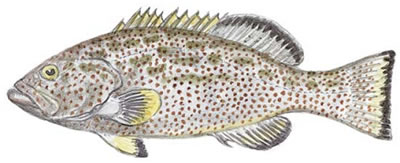The scientific name of this member of the Serranidae family means “venomous,” a reference to the yellowfin grouper’s association with ciguatera poisoning. Despite this, its flesh is good to eat and is usually considered safe for commercial sale.
Identification
The yellowfin grouper has highly variable coloring, usually with a pale background and horizontal rows of darker, rectangular blotches covering the entire fish; the ends of these blotches are rounded, and they can be black, gray, brown, olive green, or red.There are also small dark spots running across the body, which grow smaller toward the belly and usually appear bright red. The outer third of the pectoral fins is bright yellow, whereas the tail has a thin, dark, irregular edge. An overall reddish cast is present in fish from deep water, and the yellowfin grouper has the ability to change color dramatically or to pale or darken.
 |  |
